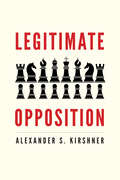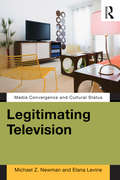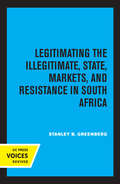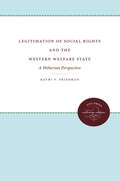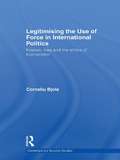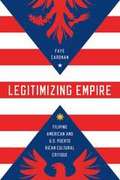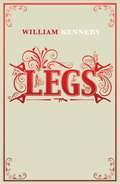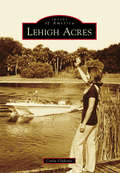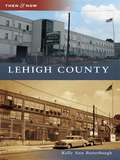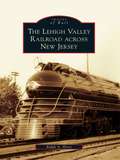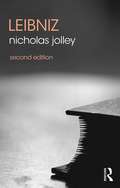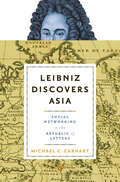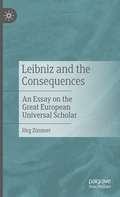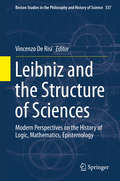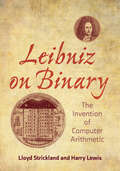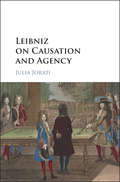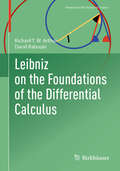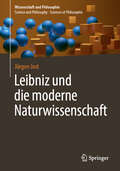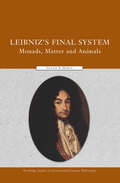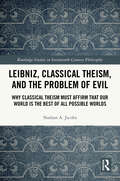- Table View
- List View
Legitimate Opposition
by Alexander S. KirshnerThe first theory of legitimate opposition in fifty years In political systems defined by legitimate opposition, those who hold power allow their rivals to peacefully challenge and displace them, and those who have lost power do not seek to sabotage the winners. Legitimate opposition came under assault at the American capitol on January 6, 2021, and is menaced by populists and autocrats across the globe. Alexander Kirshner provides the first sustained theory of legitimate opposition since the Cold War. On the orthodox view, democracy is lost when legitimate opposition is subverted. But efforts to reconcile opposition with democracy fail to identify the value of the frequently imperfect, unfair and inegalitarian real-world practice. Marshaling a revisionist reconstruction of opposition&’s history, Kirshner&’s book provides a new account of opposition&’s value fit for the twenty-first century and shows why, given the difficult conditions of political life, legitimate opposition is an achievement worth defending.
Legitimate Targets?
by Janina DillBased on an innovative theory of international law, Janina Dill's book investigates the effectiveness of international humanitarian law (IHL) in regulating the conduct of warfare. Through a comprehensive examination of the IHL defining a legitimate target of attack, Dill reveals a controversy among legal and military professionals about the 'logic' according to which belligerents ought to balance humanitarian and military imperatives: the logics of sufficiency or efficiency. Law prescribes the former, but increased recourse to international law in US air warfare has led to targeting in accordance with the logic of efficiency. The logic of sufficiency is morally less problematic, yet neither logic satisfies contemporary expectations of effective IHL or legitimate warfare. Those expectations demand that hostilities follow a logic of liability, which proves impracticable. This book proposes changes to international law, but concludes that according to widely shared normative beliefs, on the twenty-first-century battlefield there are no truly legitimate targets.
Legitimating Television: Media Convergence and Cultural Status
by Elana Levine Michael Z NewmanLegitimating Television: Media Convergence and Cultural Status explores how and why television is gaining a new level of cultural respectability in the 21st century. Once looked down upon as a "plug-in drug" offering little redeeming social or artistic value, television is now said to be in a creative renaissance, with critics hailing the rise of Quality series such as Mad Men and 30 Rock. Likewise, DVDs and DVRs, web video, HDTV, and mobile devices have shifted the longstanding conception of television as a household appliance toward a new understanding of TV as a sophisticated, high-tech gadget. Newman and Levine argue that television’s growing prestige emerges alongside the convergence of media at technological, industrial, and experiential levels. Television is permitted to rise in respectability once it is connected to more highly valued media and audiences. Legitimation works by denigrating "ordinary" television associated with the past, distancing the television of the present from the feminized and mass audiences assumed to be inherent to the "old" TV. It is no coincidence that the most validated programming and technologies of the convergence era are associated with a more privileged viewership. The legitimation of television articulates the medium with the masculine over the feminine, the elite over the mass, reinforcing cultural hierarchies that have long perpetuated inequalities of gender and class. Legitimating Television urges readers to move beyond the question of taste—whether TV is "good" or "bad"—and to focus instead on the cultural, political, and economic issues at stake in television’s transformation in the digital age.
Legitimating the Illegitimate: State, Markets, and Resistance in South Africa (Perspectives on Southern Africa #41)
by Stanley B. GreenbergThis title is part of UC Press's Voices Revived program, which commemorates University of California Press’s mission to seek out and cultivate the brightest minds and give them voice, reach, and impact. Drawing on a backlist dating to 1893, Voices Revived makes high-quality, peer-reviewed scholarship accessible once again using print-on-demand technology. This title was originally published in 1987.
Legitimating the Law: The Struggle for Judicial Competency in Early National New Hampshire
by Susan ReidJohn Phillip Reid is one of the most highly regarded historians of law as it was practiced on the state level in the nascent United States. He is not just the recipient of numerous honors for his scholarship but the type of historian after whom such accolades are named: the John Phillip Reid Award is given annually by the American Society for Legal History to the author of the best book by a mid-career or senior scholar. Legitimating the Law is the third installment in a trilogy of books by Reid that seek to extend our knowledge about the judicial history of the early republic by recounting the development of courts, laws, and legal theory in New Hampshire. Here Reid turns his eye toward the professionalization of law and the legitimization of legal practices in the Granite State—customs and codes of professional conduct that would form the basis of judiciaries in other states and that remain the cornerstone of our legal system to this day throughout the U.S. Legitimating the Law chronicles the struggle by which lawyers and torchbearers of strong, centralized government sought to bring standards of competence to New Hampshire through the professionalization of the bench and the bar—ambitions that were fought vigorously by both Jeffersonian legislators and anti-Federalists in the private sector alike, but ultimately to no avail.
Legitimation of Social Rights and the Western Welfare State: A Weberian Perspective
by Kathi V. FriedmanThis discerning and timely study revitalizes Weber's ideas, applying them to welfare state redistributions and synthesizing them with major issues in political science, law, public administration, social welfare policy, and philosophy. Friedman depicts both the emergence of the welfare state in Britain and the United States and the special problems of legitimizing social rights raised by the need for administration of those rights.Originally published in 1991.A UNC Press Enduring Edition -- UNC Press Enduring Editions use the latest in digital technology to make available again books from our distinguished backlist that were previously out of print. These editions are published unaltered from the original, and are presented in affordable paperback formats, bringing readers both historical and cultural value.
Legitimising the Use of Force in International Politics: Kosovo, Iraq and the Ethics of Intervention (Contemporary Security Studies)
by Corneliu BjolaThis book aims to examine the conditions under which the decision to use force can be reckoned as legitimate in international relations. Drawing on communicative action theory, it provides a provocative answer to the hotly contested question of how to understand the legitimacy of the use of force in international politics. The use of force is one of the most critical and controversial aspects of international politics. Scholars and policy-makers have long tried to develop meaningful standards capable of restricting the use of force to a legally narrow yet morally defensible set of circumstances. However, these standards have recently been challenged by concerns over how the international community should react to gross human rights abuses or to terrorist threats. This book argues that current legal and moral standards on the use of force are unable to effectively deal with these challenges. The author argues that the concept of 'deliberative legitimacy', understood as the non-coerced commitment of an actor to abide by a decision reached through a process of communicative action, offers the most appropriate framework for addressing this problem. The theoretical originality and empirical value of the concept of deliberative legitimacy comes fully into force with the examination of two of the most severe international crises from the post Cold War period: the 1999 NATO intervention in Kosovo and the 2003 US military action against Iraq. This book will be of much interest to students of international security, ethics, international law, discourse theory and IR. Corneliu Bjola is SSHRC Postdoctoral Fellow with the Centre for Ethics at the University of Toronto, and has a PhD in International Relations.
Legitimizing Empire: Filipino American and U.S. Puerto Rican Cultural Critique
by Faye CaronanWhen the United States acquired the Philippines and Puerto Rico, it reconciled its status as an empire with its anticolonial roots by claiming that it would altruistically establish democratic institutions in its new colonies. Ever since, Filipino and Puerto Rican artists have challenged promises of benevolent assimilation and portray U.S. imperialism as both self-interested and unexceptional among empires. Faye Caronan's examination interprets the pivotal engagement of novels, films, performance poetry, and other cultural productions as both symptoms of and resistance against American military, social, economic, and political incursions. Though the Philippines became an independent nation and Puerto Rico a U.S. commonwealth, both remain subordinate to the United States. Caronan's juxtaposition reveals two different yet simultaneous models of U.S. neocolonial power and contradicts American exceptionalism as a reluctant empire that only accepts colonies for the benefit of the colonized and global welfare. Her analysis, meanwhile, demonstrates how popular culture allows for alternative narratives of U.S. imperialism, but also functions to contain those alternatives.
Legs (Albany Cycle #1)
by William KennedyLegs inaugurated William Kennedy's critically-acclaimed cycle of novels (including Billy Phelan's Greatest Game and Ironweed) set in his hometown of Albany, New York. True to both life and myth, Legs brilliantly evokes the flamboyant career of the legendary gangster Jack "Legs" Diamond, who was finally murdered in Albany. Through the equivocal eyes of Diamond's attorney, we watch as Legs and his showgirl mistress, Kiki Roberts, blaze their gaudy trail across the tabloid pages of the 1920s and 1930s, emerging as emblematic figures from an era of American innocence -- and corruption.
Lehigh Acres
by Carla UlakovicLehigh Acres emerged from an expanse of southwest Florida's wild lands due to the vision of industrialist, inventor, and self-made millionaire Leonard Lee Ratner and his business partners in the Lee County Land and Title Company. For Ratner, southwest Florida represented a land of opportunity. In 1952, he purchased Lucky Lee Ranch in eastern Lee County as a means to maintain his fortune; however, a chance meeting in Miami with Gerald Gould, a young advertising executive, forever changed the future of this Florida ranchland. They formed a company, began subdividing the land, and devised a marketing plan to attract buyers from the Midwest and Northeast by selling dreams in "a golden land of opportunity" and touting an average temperature of 74 degrees. Soon, roadways, model homes, the Lehigh Acres Country Club and Motel, and an ultramodern auditorium brought the community to life. As the decades moved on, the company's holdings grew to 60,000 acres, making Lehigh Acres one of the largest subdivided communities in the nation. Rich in natural beauty, amenities, and activities, the dynamic marketing team convincingly sold many on the idea "that you needn't be a millionaire to live like one" in Lehigh Acres.
Lehigh County (Then and Now)
by Kelly Ann ButterbaughLehigh County has transformed throughout the years and now is a far cry from its rural identity only 50 years ago. Today Lehigh County is known as an important link to the metropolitan areas of New York City and Philadelphia.
Lehigh Township (Images of America)
by Lehigh Township Historical SocietyLehigh Township was settled in the late 1700s by immigrants who had come to work in the numerous slate quarries. Situated in the foothills of the Blue Mountains, the township represented the last signs of civilization for those traveling north from Philadelphia to the wilderness beyond the Lehigh Gap. The township has remained largely rural, with farms and open fields abundant along its two-lane highways.Compiled by members and friends of the Lehigh Township Historical Society, Lehigh Township is a collection of rare vintage photographs of the community. The Cherryville Hotel (which in its heyday was known throughout the area as one of the best places to get Pennsylvania Dutch food), local quarries, one-room schoolhouses, Dieter's Foundry, and the Indian Trail and Edgemont amusement parks make up a sampling of the countless familiar images of Lehigh Township's past. Lehigh Township is an indispensable reference for both residents and visitors.
Lehigh Valley Railroad across New Jersey, The (Images of Rail)
by Ralph A. HeissConstructed as the Easton and Amboy Railroad and opened by 1875, the Lehigh Valley Railroad was instrumental in developing the commerce and communities of central New Jersey through which it once ran. Originally built to haul unending trains of "black diamonds" from Pennsylvania to Perth Amboy, the Lehigh Valley Railroad became so much more than a conduit for shipping coal. In building across the state, it became instrumental in not only hauling produce to New York City markets but also for providing service to companies like Johns-Manville and Lionel Trains. From Phillipsburg to Jersey City and all points in between, the Lehigh Valley Railroad hauled freight and passengers, while at the same time contributing to the social fabric of the area. The Lehigh Valley Railroad across New Jersey paints a picture of a railroad that provided over 100 years of quality service to the Garden State.
Leibniz
by Maria Rosa AntognazzaOf all the thinkers of the century of genius that inaugurated modern philosophy, none lived an intellectual life more rich and varied than Gottfried Wilhelm Leibniz (1646-1716). Trained as a jurist and employed as a counsellor, librarian, and historian, he made famous contributions to logic, mathematics, physics, and metaphysics, yet viewed his own aspirations as ultimately ethical and theological, and married these theoretical concerns with politics, diplomacy, and an equally broad range of practical reforms: juridical, economic, administrative, technological, medical, and ecclesiastical. Maria Rosa Antognazza's pioneering biography not only surveys the full breadth and depth of these theoretical interests and practical activities, it also weaves them together for the first time into a unified portrait of this unique thinker and the world from which he came. At the centre of the huge range of Leibniz's apparently miscellaneous endeavours, Antognazza reveals a single master project lending unity to his extraordinarily multifaceted life's work. Throughout the vicissitudes of his long life, Leibniz tenaciously pursued the dream of a systematic reform and advancement of all the sciences, to be undertaken as a collaborative enterprise supported by an enlightened ruler; these theoretical pursuits were in turn ultimately grounded in a practical goal: the improvement of the human condition and thereby the celebration of the glory of God in His creation. As well as tracing the threads of continuity that bound these theoretical and practical activities to this all-embracing plan, this illuminating study also traces these threads back into the intellectual traditions of the Holy Roman Empire in which Leibniz lived and throughout the broader intellectual networks that linked him to patrons in countries as distant as Russia and to correspondents as far afield as China.
Leibniz (The Routledge Philosophers)
by Nicholas JolleyGottfried Wilhelm Leibniz (1646-1716) was hailed by Bertrand Russell as 'one of the supreme intellects of all time'. A towering figure in seventeenth-century philosophy, his complex thought has been championed and satirized in equal measure, most famously in Voltaire's Candide. In this outstanding introduction to his philosophy, Nicholas Jolley introduces and assesses the whole of Leibniz's philosophy. Beginning with an introduction to Leibniz's life and work, he carefully introduces the core elements of Leibniz's metaphysics: his theories of substance, identity and individuation; monads and space and time; and his important debate over the nature of space and time with Newton's champion, Samuel Clarke. He then introduces Leibniz's theories of mind, knowledge, and innate ideas, showing how Leibniz anticipated the distinction between conscious and unconscious states, before examining his theory of free will and the problem of evil. An important feature of the book is its introduction to Leibniz's moral and political philosophy, an overlooked aspect of his work. The final chapter assesses legacy and the impact of his philosophy on philosophy as a whole, particularly on the work of Immanuel Kant. Throughout, Jolley places Leibniz in relation to some of the other great philosophers, such as Descartes, Spinoza and Locke, and discusses Leibniz's key works, such as the Monadology and Discourse on Metaphysics. This second edition has been revised throughout and includes a new chapter on Leibniz and philosophy of language.
Leibniz Discovers Asia: Social Networking in the Republic of Letters (Information Cultures)
by Michael C. CarhartHow did early modern scholars—as exemplified by Leibniz—search for their origins in the study of language?Who are the nations of Europe, and where did they come from? Early modern people were as curious about their origins as we are today. Lacking twenty-first-century DNA research, seventeenth-century scholars turned to language—etymology, vocabulary, and even grammatical structure—for evidence. The hope was that, in puzzling out the relationships between languages, the relationships between nations themselves would emerge, and on that basis one could determine the ancestral homeland of the nations that presently occupied Europe.In Leibniz Discovers Asia, Michael C. Carhart explores this early modern practice by focusing on philosopher, scientist, and mathematician Gottfried Wilhelm Leibniz, who developed a vast network of scholars and missionaries throughout Europe to acquire the linguistic data he needed. The success of his project was tied to the Jesuit search for an overland route to China, whose itinerary would take them through the nations from whom Leibniz wanted language samples. Drawing on Leibniz's extensive correspondence with the members of this network, Carhart gives us access to the philosopher's scintillating discussions about astronomy and mapping; ethnology and missionary work; the contest of the Asiatic empires of Muscovy, Persia, the Ottoman, and China for control of the Caucasus, the steppes, and the Far East; and above all, language, as the best indicator of the prehistoric genealogy of the myriad peoples from Central Asia to Western Europe.Placing comparative linguistics within Leibniz's intellectual program, this book offers extensive insight into how Leibniz built his early modern scholarly network, the network's functionality within the international Republic of Letters, and its limitations. We see the scholar, isolated and lonely in little Hanover, with his hands on knowledge trickling in from scientific centers across Europe and around the world. By the end of 1697—the year his network finally began to work—Leibniz laughed to one of his patrons, "I'm putting a sign on my door reading, 'Bureau of Address for China'!" Depicting Leibniz not as a philosophical authority but as a scholar with human limitations and frustrations, Leibniz Discovers Asia is a thrilling and engaging narrative.
Leibniz and the Consequences: An Essay on the Great European Universal Scholar
by Jörg ZimmerLeibniz was probably the last universal scholar in modern times who made original and innovative achievements in all the essential fields of knowledge of his time: as a reform-oriented lawyer, a multilateral thinking diplomat, as a mathematician of infinitesimal calculus, as the inventor of a calculating machine and in the mining of horizontal wind power, as an organizer of science and as one of the first historians who strived for source-critical methodical objectivity. However, this baroque diversity can only be understood from the center of a monadological philosophy, which wants to establish the unity of scientific worldview and metaphysical concept of the world. It is distorted in the classical reception because only Leibniz the Theodicy was known. The topicality of Leibniz today consists in re-exposing the original basic idea of unity in diversity and asking how it can be made fruitful for philosophical and political thought in the 21st century. This book is a translation of the original German 1st edition Leibniz und die Folgen by Jörg Zimmer, published by J.B. Metzler, imprint of Springer-Verlag GmbH, part of Springer Nature in 2018. The translation was done with the help of artificial intelligence (machine translation by the service DeepL.com). A subsequent human revision was done primarily in terms of content, so that the book will read stylistically differently from a conventional translation. Springer Nature works continuously to further the development of tools for the production of books and on the related technologies to support the authors.
Leibniz and the Structure of Sciences: Modern Perspectives on the History of Logic, Mathematics, Epistemology (Boston Studies in the Philosophy and History of Science #337)
by Vincenzo De RisiThe book offers a collection of essays on various aspects of Leibniz’s scientific thought, written by historians of science and world-leading experts on Leibniz. The essays deal with a vast array of topics on the exact sciences: Leibniz’s logic, mereology, the notion of infinity and cardinality, the foundations of geometry, the theory of curves and differential geometry, and finally dynamics and general epistemology. Several chapters attempt a reading of Leibniz’s scientific works through modern mathematical tools, and compare Leibniz’s results in these fields with 19th- and 20th-Century conceptions of them. All of them have special care in framing Leibniz’s work in historical context, and sometimes offer wider historical perspectives that go much beyond Leibniz’s researches. A special emphasis is given to effective mathematical practice rather than purely epistemological thought. The book is addressed to all scholars of the exact sciences who have an interest in historical research and Leibniz in particular, and may be useful to historians of mathematics, physics, and epistemology, mathematicians with historical interests, and philosophers of science at large.
Leibniz in His World: The Making of a Savant
by Audrey BorowskiA sweeping intellectual biography that restores the Enlightenment polymath to the intellectual, scientific, and courtly worlds that shaped his early life and thoughtDescribed by Voltaire as &“perhaps a man of the most universal learning in Europe,&” Gottfried Wilhelm Leibniz (1646–1716) is often portrayed as a rationalist and philosopher who was wholly detached from the worldly concerns of his fellow men. Leibniz in His World provides a groundbreaking reassessment of Leibniz, telling the story of his trials and tribulations as an aspiring scientist and courtier navigating the learned and courtly circles of early modern Europe and the Republic of Letters.Drawing on extensive correspondence by Leibniz and many leading figures of the age, Audrey Borowski paints a nuanced portrait of Leibniz in the 1670s, during his &“Paris sojourn&” as a young diplomat and in Germany at the court of Duke Johann Friedrich of Hanover. She challenges the image of Leibniz as an isolated genius, revealing instead a man of multiple identities whose thought was shaped by a deep engagement with the social and intellectual milieus of his time. Borowski shows us Leibniz as he was known to his contemporaries, enabling us to rediscover him as an enigmatic young man who was complex and all too human.An exhilarating work of scholarship, Leibniz in His World demonstrates how this uncommon intellect, torn between his ideals and the necessity to work for absolutist states, struggled to make a name for himself during his formative years.
Leibniz on Binary: The Invention of Computer Arithmetic
by Lloyd Strickland Harry R. LewisThe first collection of Leibniz&’s key writings on the binary system, newly translated, with many previously unpublished in any language.The polymath Gottfried Wilhelm Leibniz (1646–1716) is known for his independent invention of the calculus in 1675. Another major—although less studied—mathematical contribution by Leibniz is his invention of binary arithmetic, the representational basis for today&’s digital computing. This book offers the first collection of Leibniz&’s most important writings on the binary system, all newly translated by the authors with many previously unpublished in any language. Taken together, these thirty-two texts tell the story of binary as Leibniz conceived it, from his first youthful writings on the subject to the mature development and publication of the binary system. As befits a scholarly edition, Strickland and Lewis have not only returned to Leibniz&’s original manuscripts in preparing their translations, but also provided full critical apparatus. In addition to extensive annotations, each text is accompanied by a detailed introductory &“headnote&” that explains the context and content. Additional mathematical commentaries offer readers deep dives into Leibniz&’s mathematical thinking. The texts are prefaced by a lengthy and detailed introductory essay, in which Strickland and Lewis trace Leibniz&’s development of binary, place it in its historical context, and chart its posthumous influence, most notably on shaping our own computer age.
Leibniz on Causation and Agency
by Julia JoratiThis book presents a comprehensive examination of Gottfried Leibniz's views on the nature of agents and their actions. Julia Jorati offers a fresh look at controversial topics including Leibniz's doctrines of teleology, the causation of spontaneous changes within substances, divine concurrence, freedom, and contingency, and also discusses widely neglected issues such as his theories of moral responsibility, control, attributability, and compulsion. Rather than focusing exclusively on human agency, she explores the activities of non-rational substances and the differences between distinctive types of actions, showing how the will, appetitions, and teleology are key to Leibniz's discussions of agency. Her book reveals that Leibniz has a nuanced and compelling philosophy of action which has relevance for present-day discussions of agency. It will be of interest to scholars and students of early modern philosophy as well as to metaphysicians and philosophers of action.
Leibniz on the Foundations of the Differential Calculus (Frontiers in the History of Science)
by David Rabouin Richard T. ArthurThis monograph presents an interpretive essay on the foundations of Leibniz’s calculus, accompanied by key texts in English translation. The essay examines Leibniz's evolving views on infinitesimals and infinite numbers, tracing their development from his early metaphysical ideas to his mature justifications of the calculus. Leibniz first proposed treating infinitesimals as fictions in the 1670s, in line with the mathematical practices of his time, where abstract concepts could be used in calculations without implying their existence. By 1676, he rejected their status as quantities, yet continued to refine his arguments on this topic into the 1690s. The essay concludes with an analysis of Leibniz’s defense of his calculus in the early 18th century, showing how his later works naturally extended from earlier insights. This monograph will be a valuable resource for scholars and students of Leibniz and the history of science.
Leibniz und die moderne Naturwissenschaft (Wissenschaft und Philosophie – Science and Philosophy – Sciences et Philosophie)
by Jürgen JostWas hat ein Gelehrter des 17.Jahrhunderts noch für die heutigen Naturwissenschaften zu sagen? Eine ganze Menge, so zeigt sich in diesem Buch. Gottfried Wilhelm Leibniz (1646-1716) war ein Universalgenie, und ihm gelangen bahnbrechende Leistungen in fast allen Gebieten der Wissenschaft, insbesondere in der Philosophie (Relativität von Raum und Zeit), der Mathematik (Infinitesimalrechnung, Determinantentheorie, binäres Zahlsystem, Konstruktion einer Rechenmaschine), der Logik (Prädikaten- und Modallogik, Konzept der möglichen Welten), der Physik (Energieerhaltung und Aktionsprinzip), der Erd- und Menschheitsgeschichte, der Rechtswissenschaft und der Theologie. Diese Leistungen waren aber nicht isoliert, sondern eingebettet in ein umfassendes System, das auf dem Satz vom Widerspruch, dem Satz vom zureichenden Grunde und dem Kontinuitätsprinzip beruhte. Erst durch das Verständnis dieses Systems erschließen sich die Einheit und die Spannweite seines Denkens. Jürgen Jost, der wie nur wenige andere die verschiedenen Wissenschaften überblickt, konfrontiert dieses leibnizsche System mit den Ansätzen, Denkweisen und Ergebnissen der heutigen Naturwissenschaften, insbesondere der Quantenphysik, der Relativitätstheorie und Kosmologie, der modernen Logik, der Evolutionsbiologie und der Hirnforschung. Es zeigt sich, dass das leibnizsche System in vieler Hinsicht noch aktuell ist und sich bewährt, aber auch in manchen Positionen revidiert werden muss. Hieraus ergeben sich neue Einsichten sowohl in das leibnizsche System als auch in die heutigen Naturwissenschaften.
Leibniz's Final System: Monads, Matter, and Animals (Routledge Studies in Seventeenth-Century Philosophy)
by Glenn A. HartzGottfried Wilhelm Leibniz was one of the central figures of seventeenth-century philosophy, and a huge intellectual figure in his age. This book from Glenn A. Hartz (editor of the influential Leibniz Review) is an advanced study of Leibniz's metaphysics. Hartz analyzes a very complicated topic, widely discussed in contemporary commentaries on Leibniz, namely the question of whether Leibniz was a metaphysical idealist, realist, or whether he tried to reconcile both trends in his mature philosophy. Because Leibniz is notoriously unclear about this, much has been written on the subject. In recent years, the debate has centered on whether it is possible to maintain compatibility between the two trends. In this controversial book, Hartz demonstrates that it is not possible to maintain compatibility of idealist and realist views - they must be understood as completely separate theories. As the first major work on realism in Leibniz's metaphysics, this key text will interest international Leibniz scholars, as well as students at the graduate level.
Leibniz, Classical Theism, and the Problem of Evil: Why Classical Theism Must Affirm That Our World is the Best of All Possible Worlds (Routledge Studies in Seventeenth-Century Philosophy)
by Nathan A. JacobsThis volume offers a defense of Leibniz’s theodicy and his infamous claim that our world is the best of all possible worlds. It considers Leibniz’s rationale for “optimism,” examines its roots in ancient and medieval thought, and forwards a novel rereading of Leibniz’s theory of freedom in light of this background, all of which highlights the very real challenges of evading optimism from within the framework of classical theism. Gottfried Leibniz is known for his “theodicy,” or defense of God's Goodness, Wisdom, and Justice despite the realities of evil in our world. This book argues that Leibniz’s optimism is inevitable for proponents of classical theism and even for many not-so-classical theists. The author’s argument is threefold. First, he demonstrates that Leibniz's theodicy is deeply rooted in the classical theist tradition, pagan and Christian, and shows that the philosopher of Leipzig is merely following these commitments to their logical conclusion, a conclusion that long precedes Leibniz. Second, he offers a novel rereading of Leibniz in the light of his philosophical and theological antecedents, a reading that, if correct, dispels ubiquitous but problematic assumptions about Leibniz's case, specifically those about divine and human freedom. Third, he demonstrates the analytic tether that connects classical theism to Leibniz’s conclusion, making his notorious optimism virtually inevitable for proponents of classical theism — and even for not-so-classical theists. This book demonstrates the ways in which Leibniz is relevant to not only classical theists and students of Modern philosophy but also to contemporary philosophers of religion more generally and philosophical theologians who are concerned with the problem of evil. Leibniz, Classical Theism, and the Problem of Evil will appeal to scholars and graduate students interested in Leibniz, philosophy of religion, history of philosophy, philosophical theology, free will, and the problem of evil.
